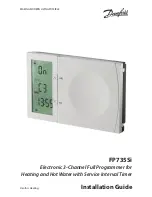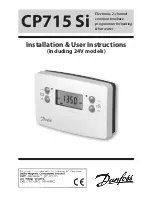
Installation 17–13
1070 072 145-102 (01.07) GB
17.3.5
Installation Procedures Ensuring Interference Resistance
Without exception, priority shall always be given to the prevention or remedy
or elimination of interference at the source. To this end, the following items
must be observed:
Earthing arrangements
To eliminate interference potentials acting between the device and refe-
rence earth, the housing must be connected to ground via a low-impedance
connection. Particularly in the case of pulsed interference with rise times in
the nanosecond range, the considerable inductive potential of simple cables
poses a significant barrier to the discharge of interference. Because earthing
straps exhibit significantly better high-frequency properties, they must al-
ways be given preference.
Screening
A major source of interference is produced by magnetic or electrical transfer.
The prevention of transfer may be achieved through the introduction of ade-
quate screening and spatial separation. In consequence, this has become
the basis for the requirement to install interference-prone components, such
as power supply and motor cables, contactors and frequency converters,
etc., separately or screened from components with a lower interference si-
gnal-to-noise ratio, such as signal lines and electronic control units.
The consistent spatial separation between potential sources and sinks of in-
terference as early as in the planning phase is the most cost-effective mea-
sure toward maximizing the interference resistance of any system.
Preference shall be given to transformers featuring shielding windings be-
cause these provide very effective interference attenuation in the higher vol-
tage range.
Twisted-pair wiring
Mainly in the case of data lines but also with power supply cables, engineers
resort to the use of twisted-pair wiring. The tightly entwined conductors pre-
vents the occurrence of interference due to transfer between the conduc-
tors.
As an important requirement the twisted-pair cable must consist of forward
and return line, which means that the flowing currents add up to zero. This is
the case with many data transmission methods and also quite common with
power supplies. Standard bus cables are supplied as twisted-pair versions.
Parallel routing of data lines and interference-prone power cables
The parallel installation of data lines or input/output signal cables and interfe-
rence-prone cables (motor cables or cables connecting contactors featuring
poor interference suppression) must be avoided. The smaller the distance of
cables routes in parallel, the larger the transferred interference.
Power cables and data lines routed in cable channels and control cabinets
must be placed at the largest possible distance of each other. The minimum
distance is 10 cm, and the preferred cable routing is in separate, screened
compartments. Intersections between data lines and power cables shall use
a 90-degree angle.
Содержание CL200
Страница 3: ...Antriebs und Steuerungstechnik CL200 Manual CL200 102 Edition ...
Страница 8: ...Contents VIII 1070 072 145 102 01 07 GB Notes ...
Страница 24: ...System Introduction 2 8 1070 072 145 102 01 07 GB Notes ...
Страница 38: ...Module Racks 3 14 1070 072 145 102 01 07 GB Notes ...
Страница 82: ...E 24 V Digital Input Modules 6 6 1070 072 145 102 01 07 GB Notes ...
Страница 104: ...Digital Input Output Modules 8 10 1070 072 145 102 01 07 GB Notes ...
Страница 110: ...DP EA4 Peripheral Bus Station Module 9 6 1070 072 145 102 01 07 GB Notizen ...
Страница 114: ...AG S Expansion Module 10 4 1070 072 145 102 01 07 GB Notizen ...
Страница 122: ...R200 R200P COM2 E Communication Modules 11 8 1070 072 145 102 01 07 GB Notizen ...
Страница 158: ...Appendix A 4 1070 072 145 102 01 07 GB Notes ...







































